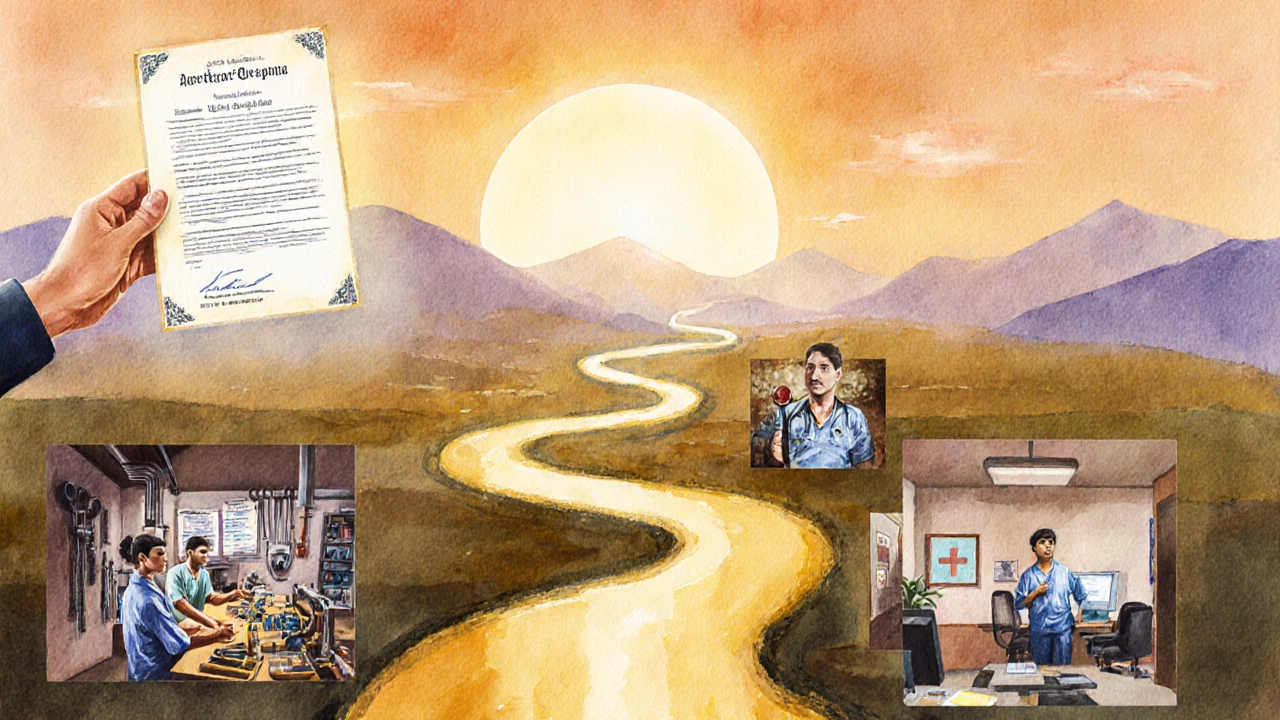Vocational Training Path Finder
Recommended Path
Your recommended vocational training path will appear here based on your selections.
People often wonder what vocational training really means and how it differs from a traditional college degree. In simple terms, it’s learning that prepares you for a specific job or trade, usually by combining classroom instruction with hands‑on practice.
Key Takeaways
- Vocational training focuses on job‑ready skills rather than academic theory.
- It comes in several formats - apprenticeships, certificate courses, diplomas, and short‑term workshops.
- India’s skill ecosystem, led by bodies like the National Skill Development Corporation (NSDC), links training to industry demand.
- Career outcomes include quicker entry into the workforce, lower tuition costs, and often higher starting salaries for skilled roles.
- Choosing the right path involves checking entry requirements, program length, certification, and industry partnerships.
What is Vocational Training?
Vocational Training is a structured learning approach that equips individuals with specific technical or practical skills required for a particular occupation. Unlike academic programs that emphasize broad knowledge, vocational training zeroes in on what you’ll actually do on the job - from wiring a circuit board to cooking a three‑course meal.
The goal is employability. Programs are designed with input from employers, so graduates often walk out with a recognized credential and a job offer waiting.
Core Types of Vocational Training
While the umbrella term covers many formats, four main types dominate the Indian landscape.
Apprenticeship
Apprenticeship is a blended learning model where a trainee works under a skilled mentor while attending classes part‑time. Typical duration ranges from 1 to 3 years. The apprentice earns a stipend and, upon completion, receives a nationally recognized certificate.
Certificate Course
Certificate Course delivers focused instruction on a single skill or a small set of related skills. Courses can last a few weeks to six months and culminate in a certification that validates competency.
Diploma Programme
Diploma Programme combines theory and practice over 1‑2 years, often covering multiple related trades. Diplomas are usually offered by polytechnics, industrial training institutes (ITIs), and some private academies.
Short‑Term Skill Workshops
Short‑Term Skill Workshops are intensive, practical sessions that last from a single day to a few weeks. They target up‑skilling or reskilling for workers already in the field.

Comparison of Major Vocational Training Formats
| Format | Typical Duration | Certification | Entry Requirement | Average Starting Salary (India) |
|---|---|---|---|---|
| Apprenticeship | 1‑3 years | National Apprenticeship Certificate | 10th pass + aptitude test | ₹2.5Lakh/yr |
| Certificate Course | Weeks‑6months | Course‑specific certificate | 10th/12th pass, sometimes no formal education | ₹2Lakh/yr |
| Diploma Programme | 1‑2years | Diploma from ITI/Polytechnic | 10th pass, sometimes 12th pass | ₹3Lakh/yr |
| Short‑Term Workshop | Days‑Weeks | Participation certificate | No formal requirement, often industry experience | ₹1.5Lakh/yr (up‑skilling boost) |
Real‑World Examples Across Sectors
Seeing concrete cases helps demystify the concept. Below are five popular vocational pathways, each paired with a real‑life example.
- Automotive Mechanic Apprenticeship: A 19‑year‑old joins an automobile service centre under a senior mechanic. Over 18 months, she learns engine diagnostics, brake replacement, and customer service. The program, backed by the National Skill Development Corporation (NSDC), awards her a certified mechanic badge, which lands her a job at a leading dealership.
- Culinary Certificate Course: A college dropout enrolls in a 4‑month culinary arts certificate at a private institute. The curriculum covers food safety, menu planning, and hands‑on cooking in a commercial kitchen. Upon graduation, she secures a junior chef role at a boutique restaurant.
- IT Support Diploma: An IT‑enthusiast completes a 2‑year diploma in Computer Hardware & Networking from an ITI. The course includes lab work on server setup and a short industry internship. He receives a diploma recognized by major tech firms and gets placed as a help‑desk technician with a starting salary of ₹3.2Lakh.
- Healthcare Assistant Short‑Term Workshop: A senior citizen attends a 6‑week workshop on basic caregiving, wound care, and geriatric communication. The workshop, organized by a local NGO in partnership with a hospital, provides a participation certificate. She uses the new skill to start a home‑care service for the elderly in her neighbourhood.
- Digital Marketing Certificate: A marketing graduate takes a 3‑month online certificate on SEO, PPC, and social media analytics offered by a recognized e‑learning platform. After passing the final assessment, she earns a certification that helps her secure a junior digital marketer role at a startup.
How Vocational Training Fits Into India’s Skill Landscape
The Indian government has launched several initiatives to mainstream skill development. The Pradhan Mantri Kaushal Vikas Yojana (PMKVY) offers free or subsidized training, while state‑level skill missions tailor programs to local industry needs. These schemes often partner with the National Skill Development Corporation (NSDC), which mobilizes private sector expertise and funding.
Industry partnerships are the glue that keeps curricula relevant. For instance, a leading aerospace manufacturer collaborates with an engineering institute to design an avionics‑maintenance apprenticeship, ensuring that trainees learn the exact tools and protocols used on the shop floor.
Another emerging trend is the rise of Skill Gap Analysis platforms that use data analytics to match learner demand with employer vacancies. This data‑driven approach reduces the mismatch between training output and job market needs.

Benefits and Common Misconceptions
Vocational training offers clear advantages, but there are myths that deter potential learners.
- Benefit - Faster Entry Into Workforce: Most programs finish within a year, letting students start earning sooner than a 3‑year degree.
- Benefit - Lower Financial Burden: Tuition fees are typically 30‑60% of a college program, and many schemes provide stipends or scholarships.
- Myth - “Only for low‑skill jobs”: Modern vocational pathways include high‑tech fields like robotics, data analytics, and renewable energy.
- Myth - “No growth potential”: Skilled trades often offer clear career ladders - e.g., apprentice → journeyman → master technician - with salary increments at each stage.
- Benefit - Industry‑Recognized Credentials: Certifications are vetted by bodies such as NSDC, ensuring they are accepted nationwide.
Choosing the Right Path - A Quick Checklist
- Identify your career goal (e.g., electrician, graphic designer, IT support).
- Check the eligibility criteria - most programs accept 10th pass, but some advanced diplomas need 12th pass or a prior certificate.
- Assess program length vs. your time availability.
- Verify the certifying authority (NSDC, AICTE, state ITI board) to ensure employer recognition.
- Look for industry tie‑ups or guaranteed placement clauses.
- Consider financial support - PMKVY, state skill scholarships, or employer‑paid apprenticeships.
- Read alumni testimonials or success stories to gauge real‑world outcomes.
Frequently Asked Questions
Frequently Asked Questions
Is vocational training only for people who cannot get a college degree?
No. Vocational training is open to anyone who wants job‑ready skills, regardless of academic background. Many college graduates opt for short‑term certificates to pivot into new fields like digital marketing or data analysis.
How is the quality of a vocational program ensured?
Credible programs are accredited by bodies such as the NSDC, AICTE, or state ITI boards. These agencies audit curricula, trainer qualifications, and infrastructure to maintain standards.
Can I get a government job with vocational training?
Yes. Many central and state government recruitment notifications list specific vocational certifications - for example, a “Welder Certificate” for PSU positions or a “Computer Operator & Programming Assistant (COPA)” certificate for clerical roles.
What is the typical salary after completing a certificate course?
Salaries vary by sector and location. In 2024‑25 data, a certified electrician earned around ₹2.5Lakh per year, while a certified digital marketer started at roughly ₹3Lakh per year in metropolitan areas.
Do I need to relocate for an apprenticeship?
Not always. Many apprenticeships are offered by local firms. However, specialized trades-like aerospace maintenance-might require moving to a hub city where the industry is concentrated.


